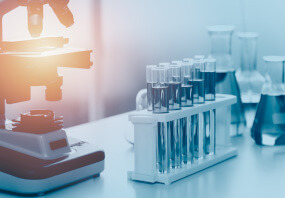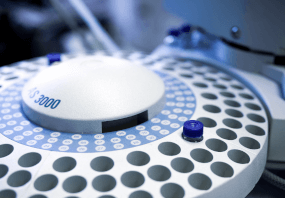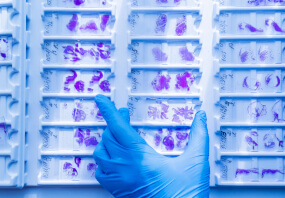General description
Hypoxia-inducible factor 1-alpha inhibitor (UniProt: Q9NWT6; also known as EC:1.14.11.30, Factor inhibiting HIF-1, FIH-1, Hypoxia-inducible factor asparagine hydroxylase) is encoded by the HIF1AN (also known as FIH1) gene (Gene ID: 55662) in human. FIH is a widely expressed, Fe(II)-dependent, homodimeric protein that in the presence of oxygen hydroxylates HIF1 at Asn 803 in the C-terminal transactivation domain. This hydroxylation prevents interaction of HIF1 activation domain with the CH-1 domain of the transcriptional co-activator p300 and reduces the transcriptional activity of HIF1 . Its homodimerization is reported to be essential for its catalytic activity. FIH is mainly cytosolic, but its interaction with NOTCH1 results in its nuclear localization and its interaction with ABPA3 results in its perinuclear localization in macrophages. Silencing of FIH gene by RNA Interference is shown to up-regulate HIF-dependent target gene expression in normoxia. (Ref.: Soilleux, EJ., et al. (2005). Histopathology. 47(6); 602-610; Stolze, IP., et al. (2004). J. Biol. Chem. 279(41); 42719-42725; Hewitson, KS., et al. (2002). J. Biol. Chem. 277(29); 26351-26355)
Specificity
Clone 162C is a mouse monoclonal antibody that specifically detects Hypoxia-inducible factor 1-alpha inhibitor (FIH).
Immunogen
His-tagged full-length recombinant human Hypoxia-inducible factor 1-alpha inhibitor (FIH) expressed in E. coli.
Application
Quality Control Testing
Evaluated by Western Blotting in MCF-7 cell lysates.
Western Blotting Analysis: A 1:500 dilution of this antibody detected FIH in MCF-7 cell lysates.
Tested Applications
Western Blotting Analysis: A representative lot detected FIH in Western Blotting applications (Stolze, I.P., et al. (2004). J Biol Chem. 279(41): 42719-25).
Immunohistochemistry Applications: A representative lot detected FIH in Immunohistochemistry applications (Soilleux, E.J., et al. (2005). Histopathology. 47(6): 602-10).
Immunofluorescence Analysis: A representative lot detected FIH in Immunofluorescence applications (Stolze, I.P., et al. (2004). J Biol Chem. 279(41): 42719-25).
Immunocytochemistry Analysis: A representative lot detected FIH in Immunocytochemistry applications (Stolze, I.P., et al. (2004). J Biol Chem. 279(41): 42719-25).
Note: Actual optimal working dilutions must be determined by end user as specimens, and experimental conditions may vary with the end user
Anti-FIH, clone 162C, Cat. No. MABE2031, is a mouse monoclonal antibody that detects Factor inhibiting HIF-1 (FIH) and is tested for use in Immunocytochemistry, Immunofluorescence, Immunohistochemistry, and Western Blotting.
Physical form
Purified mouse monoclonal antibody IgG1 in buffer containing 0.1 M Tris-Glycine (pH 7.4), 150 mM NaCl with 0.05% sodium azide.
Storage and Stability
Recommended storage: +2°C to +8°C.
Other Notes
Concentration: Please refer to the Certificate of Analysis for the lot-specific concentration.
Disclaimer
Unless otherwise stated in our catalog or other company documentation accompanying the product(s), our products are intended for research use only and are not to be used for any other purpose, which includes but is not limited to, unauthorized commercial uses, in vitro diagnostic uses, ex vivo or in vivo therapeutic uses or any type of consumption or application to humans or animals.
- UPC:
- 51131822
- Condition:
- New
- Availability:
- 3-5 Days
- Weight:
- 1.00 Ounces
- HazmatClass:
- No
- MPN:
- MABE2031-25UG












